Cicada
Cicadas have one of the longest insect lifespans
Advertisement
Cicada Scientific Classification
Read our Complete Guide to Classification of Animals.
Cicada Conservation Status
Cicada Facts
View all of the Cicada images!
If a person wakes up one warm summer morning and hears a noise outside their window like a thousand tiny lawnmowers going at full blast, it’s almost certainly a swarm of brand-new adult cicadas.
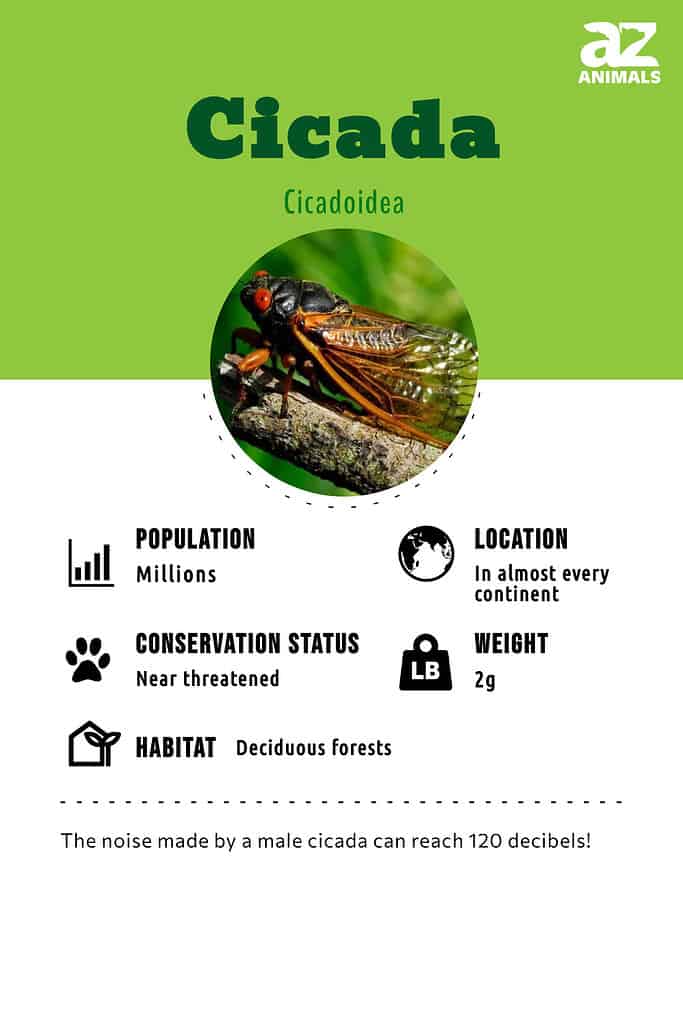
©
Cicada Brood X News & Information
Brood X emerged on the East Coast of the United States in the spring of 2021. More information and coverage can be found here!
- Cicadas in New York: What’s Happening Now?
- Cicadas in Pennsylvania: What’s Happening Now?
- Cicadas in Virginia: What’s Happening Now?
- Cicadas in Tennessee: What’s Happening Now?
- Cicadas in Washington, DC: What’s Happening Now?
- Cicadas in Maryland: What’s Happening Now?
- Here’s What 1.5 Million Cicadas Looks Like
- Will Cicadas Cause More Snakes? Copperheads?
- Can Dogs Eat Cicadas?
- Will Cicadas Eat My Tomato Plants?
- Cicada Brood X 2021: What is it and should you be concerned?
- Why Do Cicadas Only Come Out Every 17 Years?
- Cicadas vs Locusts: What’s The Difference?
Cicadas are interesting not just because of the racket they make, but because periodical cicadas have a life cycle of 13 or 17 years. Most of their lives are spent underground as nymphs, then something triggers them to emerge, climb a tree or a wall or some surface, split their skin, and emerge from the shell to become adults. After this, their only tasks are to reproduce and die.
5 Incredible Cicada Facts!
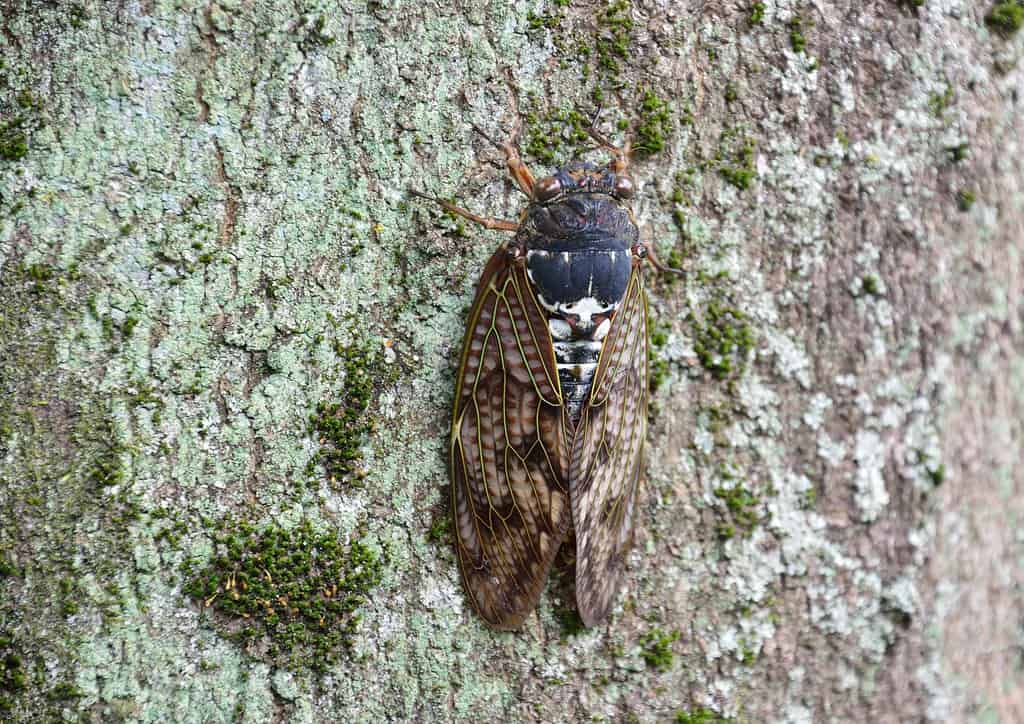
After spending years underground, the adult cicada lives only a few weeks.
©High Mountain/Shutterstock.com
- Deciduous trees are necessary for a good population of these insects. Their roots not only provide food for the nymphs but they’re important for egg-laying, molting, and singing.
- The unusually loud noise produced by a male can reach 120 decibels if heard up close. That’s loud enough to make the ears hurt.
- It’s not only humans who need to protect their ears from the loudness of the insect’s song. When a male sings, he has to close his tympana, which functions much like human ears, to keep them from being damaged.
- Scientists group periodical cicadas into broods based on their 13- or 17-year life cycle. As of 2021, there were 15 of these broods.
- After spending years underground, the adult insect lives only a few weeks. Many don’t even live that long, as they are eaten by predators such as birds and a wasp called the cicada killer. Even humans eat them. In some cultures, the insect is a delicacy.
Cicada vs. Locust
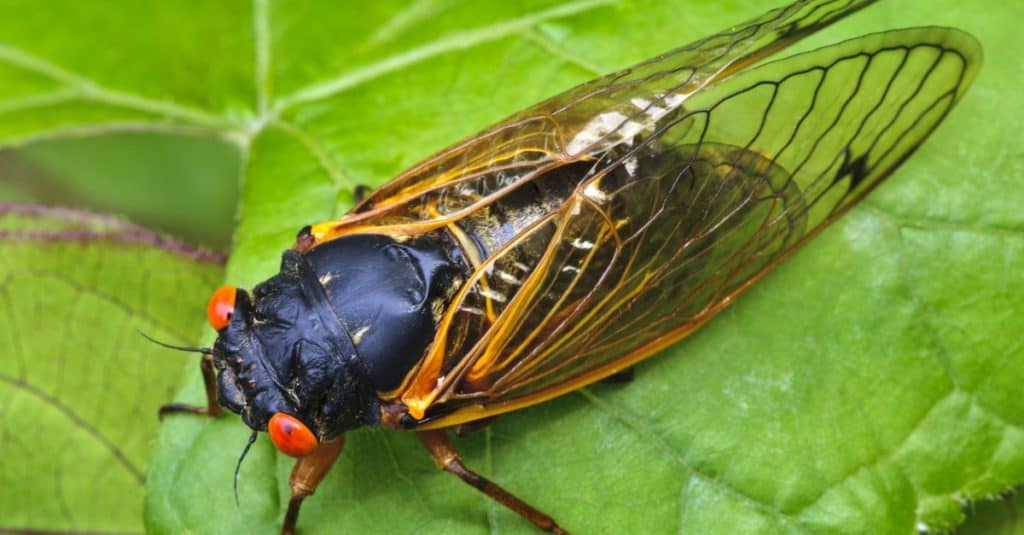
Cicadas are actually not closely related to locusts, as cicadas are considered true bugs.
©Mary Terriberry/Shutterstock.com
Though they’re sometimes called locusts, these insects are not closely related to them. Locusts, the name given to grasshoppers that have joined swarms that attack crops, belong to the Orthoptera order. Cicadas belong to the Hemiptera order and are considered true bugs. A bug is an insect with mouthparts for sucking and piercing. The insect nymph’s mouth parts are made for piercing tree roots and sucking sap, and the proboscis of a grown cicada can pierce a person’s skin, but these insects are neither venomous nor disease vectors.
Locusts have chewing mouthparts and, famously, hind legs that are adapted for jumping. Cicadas not only can’t jump the way locusts do, but they also don’t even run or walk well. If they need to go somewhere, they almost always fly.
Species, Types, and Scientific Name
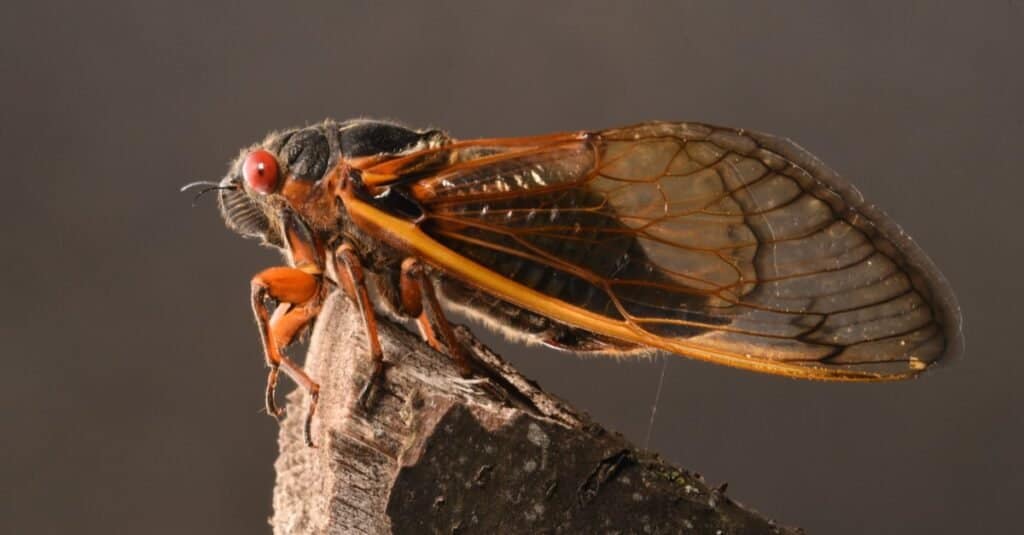
Cicada songs are very loud.
©1979825168/Shutterstock.com
In total, there are more than 3,000 different species of cicadas around the world, and about 190 of those species occur in North America. Cicadas are part of a superfamily, the Cicadoidea. Then, this is divided into two families, the Tettigarctidae, with two species in Australia, and the Cicadidae.
The periodical cicadas belong to the Magicicada genus, and the name refers to the way the insects appear like magic. Then, like magic, they disappear all at once. The name “cicada” is from Latin and allegedly describes the sound the insect makes. These bugs are exclusive to North America.
There are seven species of periodical cicadas. The first three of the species emerge after 17 years, while the other four emerge after 13 years. They are:
- the 17-year “locust” — Magicicada septendecim
- the 17-year dwarf periodical cicada — M. cassinii
- M. septendecula
- M. tredecim
- M. neotredecim
- M. tredecassini
- M. tredecula
On the other hand, there are annual cicadas. These have a lifecycle of 2-3 years and do not have synchronized life cycles. These annual cicadas are broken into 4 genera: Neotibicen (“dog-day cicadas”), Diceroprocta, Neocicada, and Okanagana.
Appearance: How To Identify Cicadas
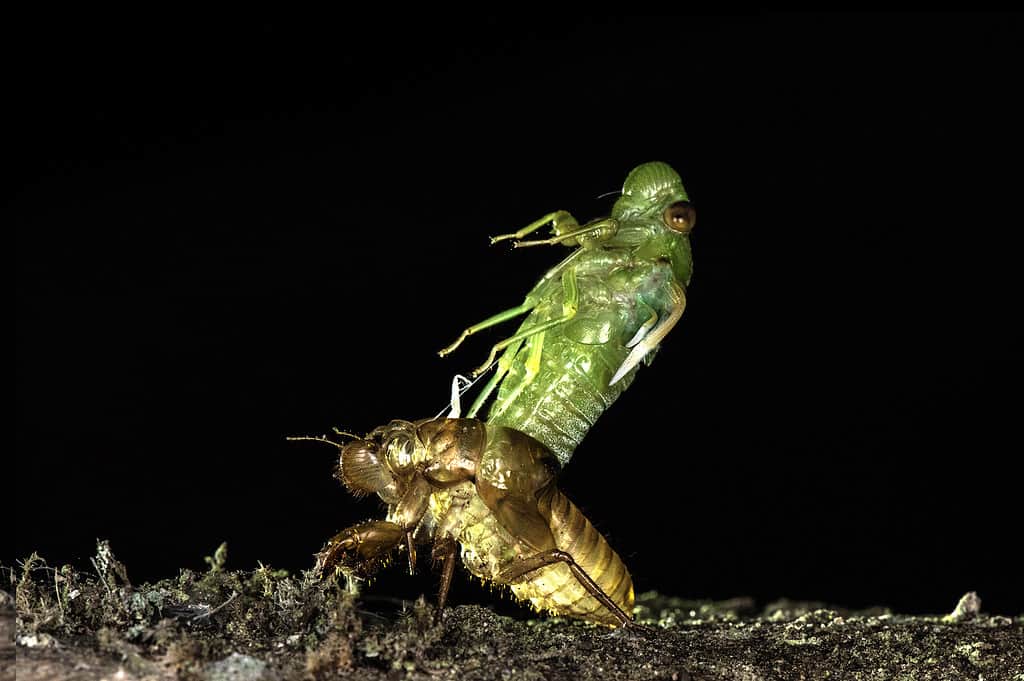
When the adult cicadas emerge, they leave their old shells behind on a wall or a tree trunk.
©Norjipin Saidi/Shutterstock.com
The periodical cicada is a rather large insect, though it’s smaller than the annual cicada, which can be 2 inches long. It is much smaller than the largest cicada. This is a Malaysian emperor cicada, with an 8-inch wingspan. Periodical cicadas are between 0.9 and 1.3 inches long, and the females are a bit bigger than the males.
Like most other insects, the insect has six legs. A person can see through their wings, which sport lacy orange veins. The insect’s thorax, or the middle section of its body, is usually black, and the abdomen can be orange, black, or orange and black striped. The insect has conspicuous red eyes.
Many of them avoid predators through camouflage or through Batesian mimicry. This is where their colors remind a predator of a harmful insect such as a wasp. These insects are capable of lowering the volume of their song or turning it off altogether if it senses a predator is nearby.
Periodical cicadas can be said to swarm. These individuals are most interested in reproducing, and males will mate with several females. When the adults emerge, they leave their old shells behind on a wall or a tree trunk. Sometimes the shell lasts longer than the insect itself.
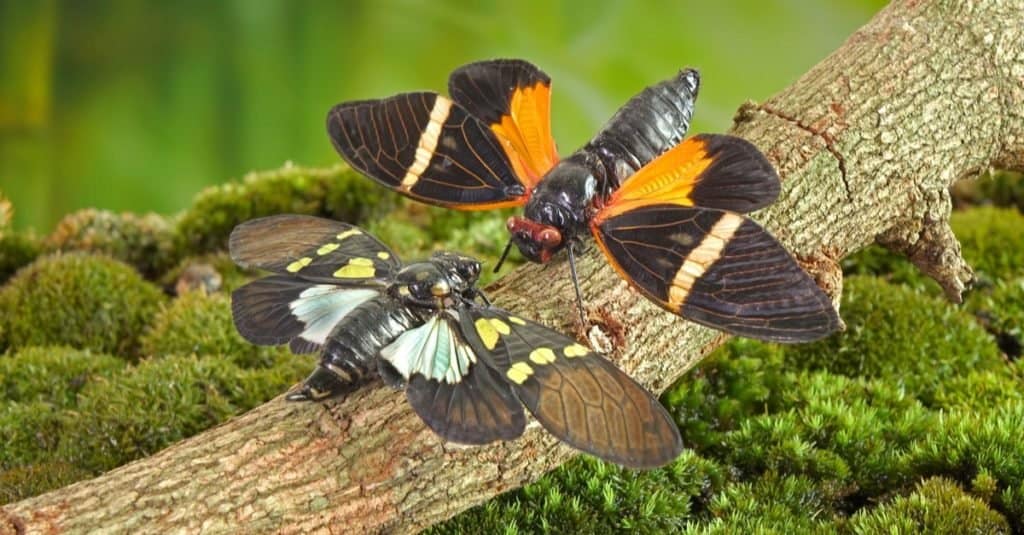
Butterfly cicadas with broad multicolor wings.
©Mark Brandon/Shutterstock.com
Habitat: Where to Find Cicadas
These insects are found all over the world, but periodical cicadas are found in the eastern and central parts of North America. Another family, the Tettigarctidae, is found in Australia.
Periodical cicadas are found in deciduous forests. These are forests made up of hardwood trees such as oaks, maples, and willows. Periodical cicadas emerge every 13 or 17 years, but even annual cicadas may not emerge every year as their name suggests. Some annual cicadas have a lifecycle of two years while others have a life cycle as long as a decade. Annual cicadas also don’t synchronize their broods the way periodical cicadas do, so they usually don’t swarm like periodicals.
Diet: What Do Cicadas Eat?
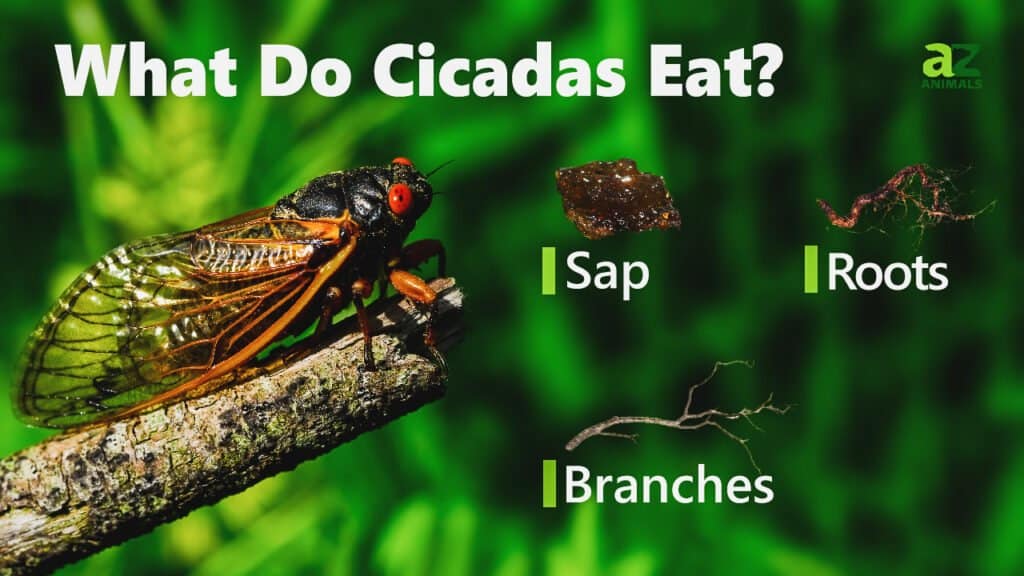
The nymphs drink the sap from the roots of deciduous trees for the long years they are underground. Though many people believe that adults don’t eat, they’ve been seen to suck sap from plants.
Prevention: How to Get Rid of Cicadas
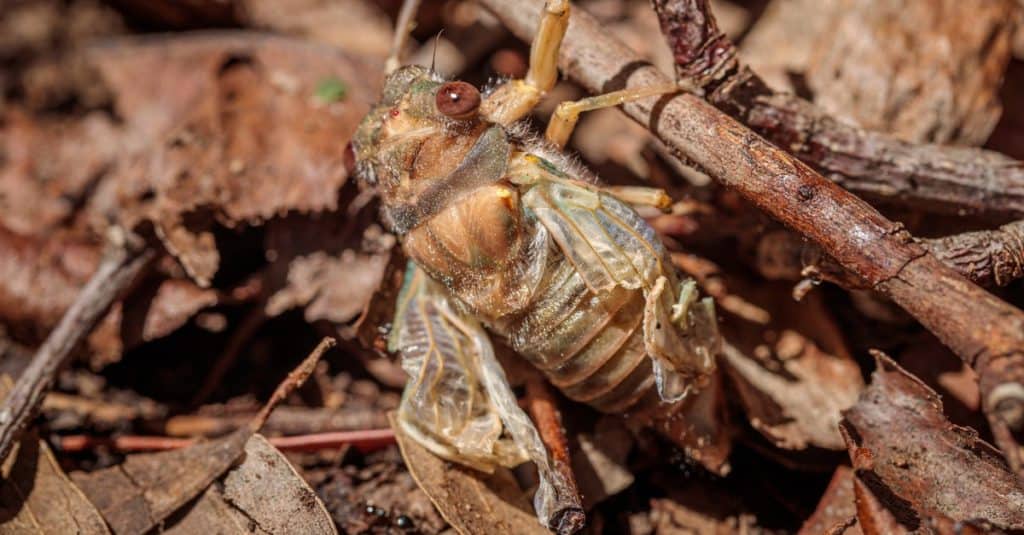
Even though they sound big and scary, cicadas are harmless to people.
©iStock.com/Jonathan Steinbeck
These insects are considered to be harmless. They don’t sting or spread diseases, even though a jab from their mouthparts can hurt. If a person is worried about the insects invading their garden, they can cover their plants with garden fleece to both dissuade the insects from feeding and the females from laying their eggs. The females cut slits in branches and then deposit their eggs in them. This may injure a young shrub or tree.
Origin and Evolution
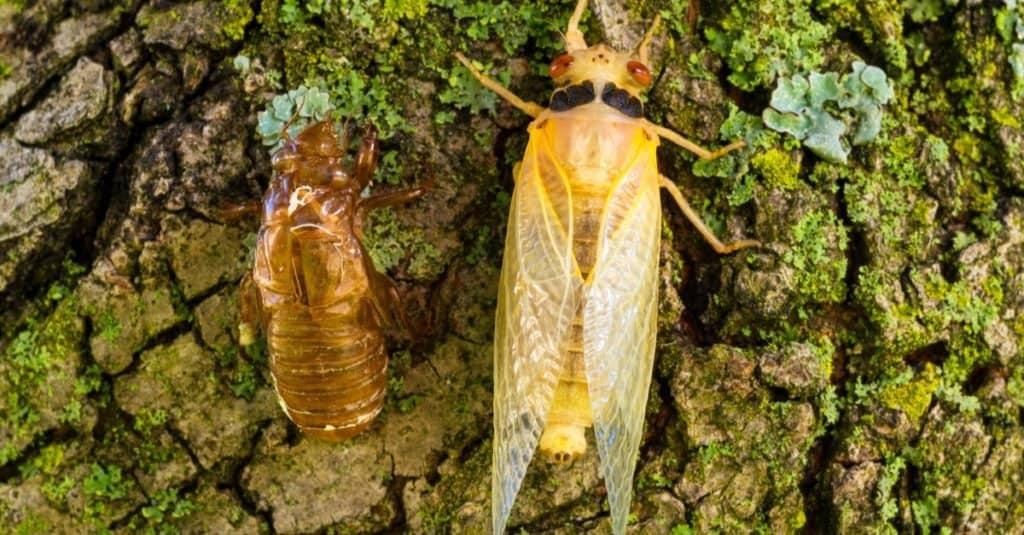
Cicadas have been around for a long time and have gone through adaptations to stay alive.
©Kenneth Sponsler/Shutterstock.com
The cicada has been around a long time, all the way from when dinosaurs roamed the earth. The fossils of Cicadomorpha noted that these bugs first appeared in the Late Triassic period. These were found in Australia, South Africa, and China. “Giant cicada” fossils were found in Eurasia and South America, and dated as from the Jurassic and Lower Cretaceous periods. The first of these was a forewing discovered in 1873 in the Taynton Limestone Formation of Oxfordshire, England. It was initially thought to be from a butterfly, but later correctly classified.
For periodic cicadas, much of their emergence and evolution has to do with the temperature. If it is too cold, a brood will not emerge and perhaps die out.
View all 235 animals that start with CCicada FAQs (Frequently Asked Questions)
What is a cicada?
A cicada is a type of bug, which means it has mouthparts that evolved for piercing and sucking. It is of interest because of its lifecycle and the great noise that a crowd of male cicadas make to attract females of their species.
What does a cicada look like?
A cicada is a somewhat large insect with translucent, veined wings. Periodical cicadas are mostly dark with wide-spaced red eyes. Cicadas have three joints in the front segment of their legs, and antennae that are cone-shaped at the base. Another characteristic that separates cicadas from other bugs is that they have three tiny eyes at the top of their head in the shape of a triangle.
Cicada nymphs are squat, lack wings, and have front legs that are made for digging. Nymphs have been found as far as 8 feet in the ground. The nymph has to go through five stages before it matures.
What does a cicada sound like?
To many people the cicada really sounds like a tiny motor winding up, hitting a crescendo, then winding down. To others, it sounds like someone singing, “Pharaoh,” which gives one species of cicada its common name. Other cicadas buzz and tick, while others produce high-pitched sounds humans can’t hear but are painful to dogs.
How do you pronounce cicada?
Cicada is pronounced “Sik KAY dah.”
Where are cicadas found?
Cicadas are found all around the world, and most species are actually found in the tropics. The famous periodical cicadas are found in North America, especially in the eastern part of the United States.
What do cicadas eat?
Cicadas drink the sap of plants. When they are nymphs, they suck the sap from tree roots. As the years go by, they dig deeper into the ground to find the deepest roots of the tree.
Can cicadas hurt you?
Cicadas can’t hurt people, though they can jab with their proboscis. They lack venom, don’t sting, and don’t spread diseases.
Why do cicadas take 17 years?
Scientists believe that the cicada’s unusual lifecycle is an adaptation to save the species from being wiped out by predators. A predator can’t specialize in cicadas the way an anteater specializes in ants and termites, because it will starve before there’s a good crop of cicadas. When cicadas do emerge, they do so in such huge numbers that they can afford predators glutting themselves on newly hatched insects.
Scientists believe that nymphs know when to come out of the ground by counting the ebbing and flowing of the sap they feed on. When 13 or 17 cycles have been completed and the soil reaches 65 degrees Fahrenheit, the nymph emerges.
What year will the cicadas come back?
The next brood of 17-year cicadas is scheduled to emerge in 2021, and the next brood of 13-year cicadas will probably emerge in 2024.
What is the difference between a katydid and a cicada?
The main differences between katydids and cicadas are their appearance (size and shape), their song, and their reproduction cycle.
Thank you for reading! Have some feedback for us? Contact the AZ Animals editorial team.
Sources
- Cicada Mania / Accessed April 11, 2021
- National Geographic / Accessed April 11, 2021
- Wikipedia / Accessed April 11, 2021
- Animal Diversity Web / Accessed April 11, 2021
- How Stuff Works / Accessed April 11, 2021


















